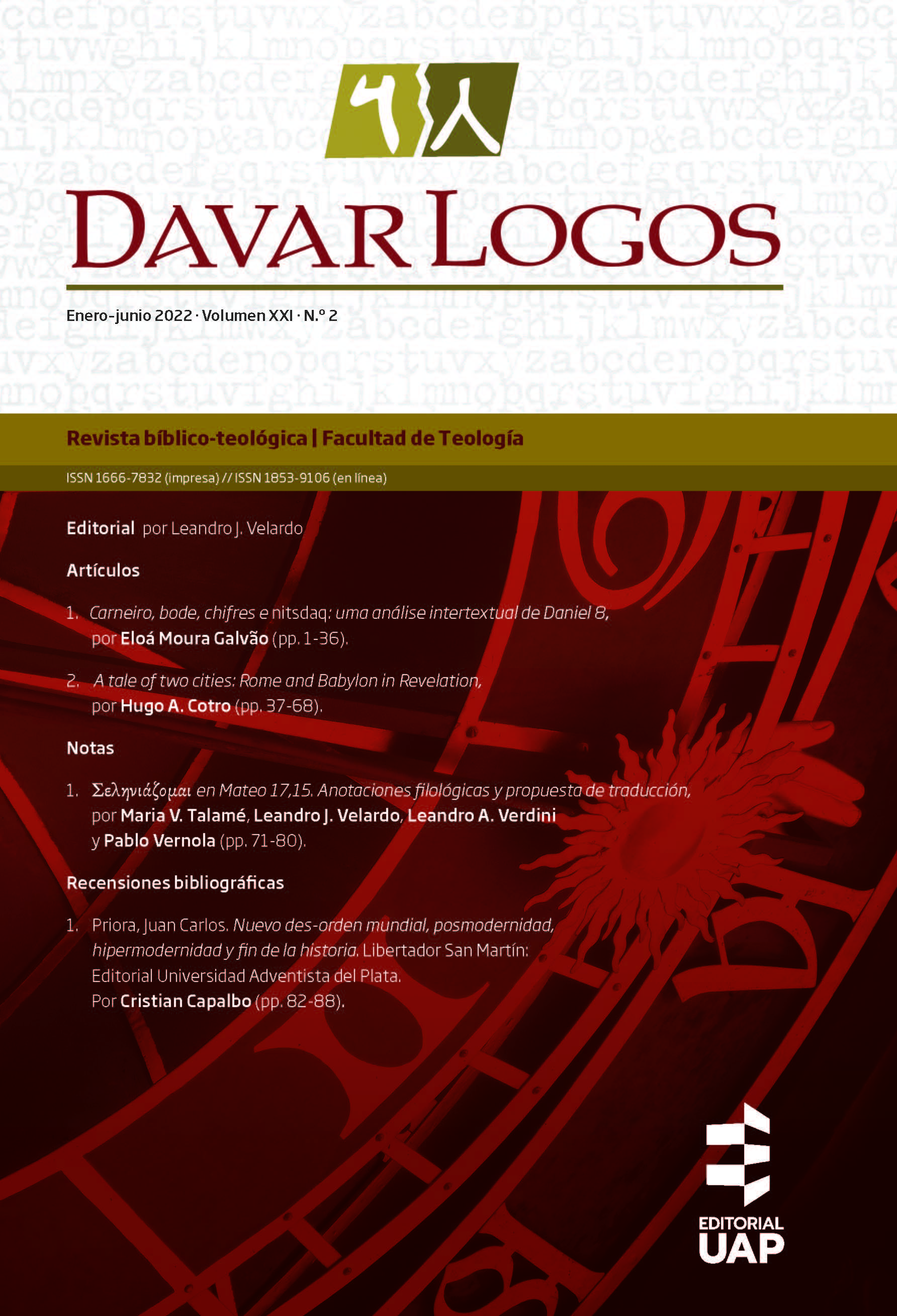Σεληνιάζομαι en Mateo 17,15. Anotaciones filológicas y propuesta de traducción
DOI:
https://doi.org/10.56487/dl.v21i2.1037Resumen
Maria V. Talamé - Leandro J. Velardo - Leandro A. Verdini - Pablo Vernola
Descargas
Referencias
E. g.: “está lunático” (Nácar-Colunga; Bover-Cantera; Cantera-Iglesias; Biblia de Navarra); “es lunático” (Reina-Valera 1960/1977/1995; Reina-Valera Antigua; Biblia de Jerusalén; Biblia del Jubileo; Sagrada Biblia de la Conferencia Episcopal Española); “tiene epilepsia” (Nueva Biblia Española); “es epiléptico” (La Biblia de las Américas; La Biblia Latinoamericana;
La Biblia. Libro del Pueblo de Dios; Biblia de la Iglesia en América). Otras propuestas de traducción son: “le dan ataques” (Dios Habla Hoy; Nueva Traducción Viviente; Nueva Versión Internacional; Palabra de Dios para Todos); “sufre de terribles ataques” (Traducción en Lenguaje Actual); “tiene ataques” (Biblia de América); “está enfermo de la mente” (Nueva Biblia Viva). Dos traducciones críticas anotadas españolas del Nuevo Testamento griego de reciente aparición son representativas del estado de la cuestión: (1) Josep Montserrat, “Evangelio de Mateo”, en Los libros del Nuevo Testamento, ed. por Antonio Piñero, trad. y comentario (Madrid, ES: Trotta, 2021), 627 (“lunáticos”, Mt 4,24), 676 (“lunático”, Mt 17,15); (2) José L. Calvo Martínez, Los cuatro evangelios: introducción, traducción y notas (Madrid, ES: Trotta, 2022), 107 (“epilépticos”, Mt 4,24), 179 (“epiléptico”, Mt 17,15). De igual modo, en el caso de exégetas y comentaristas, las traducciones al uso discurren entre “lunático” y “epiléptico”, e. g., Josef Schmid, Das Evangelium nach Matthäus, RNT (Regensburg, DE: Friedrich Pustet, 1965), 73 (Mondsucht [= Epilepsie; vgl. 17,15]); Donald A. Hagner, Matthew 14-28, WBC (Dallas, TX: Word, 1995), 503 (“… the term σεληνιάζεται, lit. ‘moonstruck’ [cf. ‘lunacy,’ probably a case of epilepsy; in the NT the word is used only by Matthew here and in 4:24, where it occurs in a list of those healed by Jesus and follows the word δαιμονιζομένους, ‘demon possessed’]); Warren Carter, Matthew and the margins: A sociopolitical and religious reading (Sheffield, GB: Sheffield Academic Press, 2000), 126 (“The term epileptics literally means ‘moonstruck’”); Ulrich Luz, Matthew 8-20: A commentary on the Gospel of Matthew, Hermeneia (Minneapolis, MN: Fortress Press, 2001), 407 (Moon sickness is epilepsy); William D. Davies y Dale C. Allison, A critical and exegetical commentary on the Gospel according to Saint Matthew, ICC (Londres: T&T Clark, 2004), 1:721-722 (“The First Evangelist has in effect correctly diagnosed the boy as having epilepsy. […] One must keep in mind, however, that for Matthew there is no thought of a purely physical affliction. The problem is caused by a malign spirit”); John Nolland, The Gospel of Matthew: A commentary on the Greek text, NIGTC (Grand Rapids, MI: Eerdmans, 2005), 711 (“σεληνιάζεται [‘subject to epilepsy’] is Matthew’s language”). Richard T. France, por su parte, afirma: “selēniazomai was not used at this time to mean epilepsy as such” (The Gospel of Matthew, NICNT [Grand Rapids, MI: Eerdmans, 2007], 659). En esta línea, Peter Bolt constata: “The vocabulary of epilepsy was used well before the first century (e.g., ἐπίληψις: Hipp. Coa praes. 587, Morb. Sacr. 10, Arist. Pr. 960a18; ἐπιληψία: Hipp. Aph. 3.22, Arist. Fr. 370), as was that associated with madness (e.g., μανία: Hdt. 6.112, Hipp. Aph. 7.5, Soph. Ant. 958; ἐξίστημι: Eur. Or. 1021, Arist. HA 577912)” (Jesus’ defeat of death: Persuading Mark’s early readers, SNTSMS 125 [Cambridge, GB: Cambridge University Press, 2003], 66, nota 82). Timothy Martin Lewis, quien realiza una serie de incisivas observaciones lexicográficas y lexicológicas al momento de examinar lexemas de baja frecuencia que explican las limitaciones de las equivalencias sugeridas, concluye que la afección del muchacho “sits comfortably here with the presence of a demon as its cause” (“Lexemes with high risk of infection: Methodology for examining low-frequency lexemes”, en Reflections on lexicography: Explorations in ancient Syriac, Hebrew, and Greek sources, PLAL 4, ed. por Richard A. Taylor y Craig E. Morrison [Piscataway, NJ: Gorgias Press, 2014], 25-62, aquí 49).
Por ejemplo, John L. McKenzie lo titula “curación de un muchacho epiléptico”, pero dice que, dado los síntomas, el muchacho “estaba lunático” (“Evangelio de Mateo”, en Comentario bíblico “San Jerónimo”, ed. por Raymond E. Brown, Joseph A. Fitzmyer y Roland E. Murphy [Madrid, ES: Cristiandad, 1972], 3:242). Antonio Rodríguez Carmona traduce “lunático”, pero titula la perícopa: “El endemoniado epiléptico” (Evangelio de Mateo, CNBJ, 2.ª ed. [Sevilla, ES: Desclée De Brouwer, 2006], 163). John Wilkinson, bajo su punto de vista, advierte que “… to conclude that this boy suffered from epilepsy is not thereby to exclude the possibility that his illness was due to demon possession” (“The case of the epileptic boy”, The Expository Times 79, n.º 2 [1967]: 42).
Luz, Matthew 8-20, 407-408. Seguidamente, Luz añade: “In the history of interpretation Origen represents an important turning point. As the first to confront the natural, medical explanation of illness on the basis of the biblical text, he expressly rejects it by appealing to scripture” (ibíd., 408). Para el comentario de Orígenes, véase Erich Klostermann, ed., Origenes Werke, Band 10: Origenes Matthäuserklärung I, GCS 40 (Leipzig, DE: J. Hinrichs’sche Buchhandlung, 1935), 189-190.
Algunos autores, como Xabier Pikaza (Evangelio de Mateo [Navarra, ES: Verbo Divino, 2016], 620) o Salvador Carrillo Alday (El Evangelio según san Mateo [Navarra, ES: Verbo Divino, 2010], 152), vinculan el caer en el fuego y en el agua con los ciclos de la Luna. José L. Sicre afirma, sin más, que podría tratarse de un caso de “sonambulismo peligroso” (El Evangelio de Mateo, EB [Navarra, ES: Verbo Divino, 2019], 306).
Para un abordaje historiográfico diacrónico de los distintos conceptos y fenómenos asociados a la “epilepsia”, ver Owsei Temkin, The falling sickness, 2.ª ed. (Baltimore, MD: Johns Hopkins Press, 1971), esp. 3-81; Mervyn J. Eadie y Peter F. Bladin, A disease once sacred (Eastleigh: John Libbey & Company, 2001). Sobre la “enfermedad sagrada” (ἱερῆς νούσου), el locus classicus se halla en la tradición hipocrática (William H. S. Jones, trad., Hippocrates II, LCL 148 [Cambridge, MA: Harvard University Press, 1923], 138-183).
Véase, entre otros, Paul J. Achtemeier, “Miracles and the historical Jesus: A study of Mark 9:14-29”, Catholic Biblical Quarterly 37 (1975): 473-475.
Así, por ejemplo, Gregory Sterling, “Jesus as exorcist: An analysis of Matthew 17:14-20; Mark 9:14-29; Luke 9:37-43a”, Catholic Biblical Quarterly 55 (1993): 472-477, cf. también la bibliografía allí citada.
Institut für Neutestamentliche Textforschung, ed., Novum Testamentum Graece, 28.ª rev. ed. (Stuttgart, DE: Deutsche Bibelgesellschaft, 2012), 54.
Es de notar el influjo teológico veterotestamentario tras el ruego (κύριε, ἐλέησόν μου τὸν υἱόν), e. g., LXX-Sal 40,5 (Κύριε, ἐλέησόν με).11 (κύριε, ἐλέησόν με); 122,3 (κύριε, ἐλέησον ἡμᾶς); LXX-Is 33,2 (κύριε, ἐλέησον ἡμᾶς). Ver también Mt 9,27 (ἐλέησον ἡμᾶς); 15,22 (ἐλέησόν με); 20,30.31 (ἐλέησον ἡμᾶς).
Hemos de destacar, aquí, la presencia del adverbio de modo κακῶς, que indica la gravedad de la condición, y el hecho de que estamos ante un incidente en el que un padre intercede por su hijo: μου τὸν υἱόν (v. 15), cf. Mc 9,17 (τὸν υἱόν μου); Lc 9,38 (τὸν υἱόν μου, ὅτι μονογενής μοί ἐστιν).
Cf. Pierre Chantraine, Dictionnaire étymologique de la langue grecque (París, FR: Klincksieck, 1999), 995; Robert S. P. Beekes, Etymological dictionary of Greek, 2 vols. (Leiden, NL: E. J. Brill, 2010), 2:1318-1319.
Cf. Henry G. Liddell, Robert Scott y Henry S. Jones, eds., A Greek-English lexicon, 9.ª ed. (Oxford, GB: Oxford University Press, 1996), 1590 (“to be moonstruck, i.e. epileptic”); Lorenzo Rocci, Vocabolario greco-italiano, 37.ª ed. (Roma, IT: Società Editrice Dante Alighieri, 1993), 1659 (“sono lunatico”); Anatole Bailly, Dictionnaire grec-français, 26.ª ed. (París, FR: Hachette, 1963), 1739 (“être épileptique”); Franco Montanari, The Brill dictionary of ancient Greek (Leiden, NL: E. J. Brill, 2015), 1902 (“to be epileptic, suffer from epilepsy”); Evangelinus A. Sophocles, Greek lexicon of the Roman and Byzantine periods (from B.C. 146 to A.D. 1100) (Nueva York, NY: Charles Scribner’s Sons, 1900), 983 (“to be lunatic”); Johannes P. Louw y Eugene A. Nida, Greek-English lexicon of the New Testament: Based on semantic domains, 2 vols., 2.ª ed. (Nueva York, NY: United Bible Societies, 1996), 1:271 (to suffer epileptic seizures [associated in ancient times with the supernatural power of the moon]), nótese que Louw y Nida sitúan σεληνιάζομαι en el campo semántico: “Physiological processes and states”, y en el subcampo: “Sickness, disease, weakness”; Walter Bauer, William F. Arndt, Felix W. Gingrich y Frederick W. Danker, Greek-English lexicon of the New Testament and other early Christian literature, 3.ª ed. (Chicago, IL: Chicago University Press, 2000), 919 (“be an epileptic”); Geoffrey W. H. Lampe, A patristic Greek lexicon (Oxford, GB: Clarendon Press, 1961), 1228 (“be moonstruck, lunatic, epileptic, possessed”).
Adolf Jülicher et al., eds., Itala, das Neue Testament in altlateinischer Überlieferung. Matthäus-Evangelium, 4 vols., 2.ª ed. (Berlín: Walter de Gruyter, 1972), 1:121 (lunaticus est | quoniam vexatur daemonio / cadet a daemonio); Johannes Wordsworth y Henry J. White, eds., Novum Testamentum domini nostri Jesu Christi latine secundum editionem s. Hieronymi ad codicum manuscriptorum fidem, 3 vols. (Oxford, GB: Clarendon, 1889-1954), 1:111 (lunaticus est); Robert Weber y Robert Gryson, eds., Biblia sacra iuxta Vulgatam versionem, 5.ª ed. rev. (Stuttgart, DE: Deutsche Bibelgesellschaft, 2007), 1552 (lunaticus est).
Sobre lūnāticus, véase Peter G. W. Glare, ed., Oxford Latin dictionary (Oxford, GB: Clarendon Press, 1968), 1050 (“Moon-struck, epileptic”), cf. Vetus Latina (quoniam vexatur daemonio [ff2 q] … cadet a daemonio [ff1]).
Agnes S. Lewis, The old Syriac Gospels or Evangelion da-Mepharreshe: Being the text of the Sinai or Syro-Antiochian palimpsest, including the latest additions and emendations, with the variants of the Curetonian text (Londres, GB: Williams & Norgate, 1910), 45 (); Francis C. Burkitt, Evangelion da-Mepharreshe: The Curetonian Syriac Gospels, re-edited, together with the readings of the Sinaitic palimpsest and the early Syriac patristic evidence, 2 vols. (Cambridge, GB: Cambridge University Press, 1904), 1:96 (); Philip E. Pusey y George H. Gwilliam, eds., Tetraeuangelium sanctum juxta simplicem Syrorum versionem ad fidem codicum, massorae, editionum denuo recognitum (Oxford, GB: Clarendon, 1901), 106 ().
Michael Sokoloff cita Mt 17,15 bajo el lema (Vetus Syra [curetoniana] y Pešitta) y sugiere la perífrasis: “lunatic demon”, y bajo (Vetus Syra [sinaítica]) apunta: “experiencing epileptic seizures” (A Syriac lexicon [Winona Lake, IN: Eisenbrauns, 2009], 178 [], 1194 []).
George W. Horner, ed., The Coptic version of the New Testament in the Southern dialect, otherwise called Sahidic and Thebaic, with critical apparatus, literal English translation, register of fragments and estimate of the version, 7 vols. (Oxford, GB: Clarendon, 1911-1924), 1:180 (ϥϩⲓⲧⲉ); George W. Horner, ed., The Coptic version of the New Testament in the Northern dialect, otherwise called Memphitic and Bohairic, with introduction, critical apparatus, and literal English translation, 4 vols. (Oxford, GB: Clarendon, 1898-1905), 1:148 (ⲙⲡⲉⲣⲙⲟⲩ).
Walter E. Crum señala que en Mt 17,15 tanto ϩⲓⲧⲉ (sahídico) como ⲡⲉⲣⲙⲟⲩ (bohaírico) denotan “be lunatic” (A Coptic dictionary [Oxford, GB: Clarendon Press, 1939], 269).
Marten Stol sostiene que la evidencia sinóptica supone la creencia helenística de que ciertos demonios causaban ataques epilépticos que se repetían a partir del ciclo lunar (Epilepsy in Babylonia, CM 2 [Groningen, NL: Styx, 1993], 121-124). La fuente más relevante que aduce —en relación con nuestra perícopa y los textos sinópticos— es PGM CXIV. 1-14: “[Protect] her, NN, O lord, [from all] evil acts [and from every] demonic visitation [and] […] of Hekate and from… / attack and [from every onslaught (?)] in sleep… [from] mute daimons [and from every] epileptic fit [and from all] epilepsy / and… and…” (Hans D. Betz, The Greek magical papyri in translation, 2.ª ed. [Chicago, IL: University of Chicago Press, 1986], 313).
En todo caso, la mención de entidades divinas/celestes, espirituales o demoníacas es un dato común a todas las fuentes. En tal sentido, Schmid observa con acierto: “Eine bloß natürliche Epilepsie, die nicht auf Besessenheit zurückgeführt wurde, gab es für die antiken Schriftsteller nicht” (Das Evangelium nach Matthäus, 264). Véase también Hermann L. Strack y Paul Billerbeck, Kommentar zum Neuen Testament aus Talmud und Midrasch, 4 vols. (Múnich, DE: C. H. Beck, 1922-1928), 1:758; Michael Zellmann-Rohrer, “Hippocratic diagnosis, solomonic therapy, Roman amulets: Epilepsy, exorcism, and the diffusion of a Jewish tradition in the Roman world”, Journal for the Study of Judaism 53, n.º 1 (2022): 69-93.
Por último, asumir una distinción tajante entre δαιμονίζομαι y σεληνιάζομαι sobre la base de Mt 4,24 no hace justicia al cotexto de Mt 17,15, a la evidencia sinóptica y al uso de σεληνιάζομαι y ἐπιληπτικός en fuentes extrabíblicas, e. g., Orphica Lithica kerygmata 47.12 (σεληνιαζομένους τε καὶ ἐπιληπτικοὺς καὶ ὑδρωπικούς); Cyranides 4.68.7 (ἐπιληπτικοὺς καὶ σεληνιακοὺς).
Además de lo dicho, obsérvese el sentido figurado de ἐξέρχομαι, en el v. 18, que, en el presente cotexto, refiere al espíritu que sale del muchacho, y el uso de ἐκβάλλω, en el v. 19, que conlleva el sentido técnico de expulsar un demonio/espíritu de una persona.
Montserrat desatiende la distinción lingüística entre voz y diátesis al traducir: “pues muchas veces se tira al fuego y muchas veces al agua” (“Evangelio de Mateo”, en Los libros del Nuevo Testamento, 676, énfasis añadido); la función semántica del sujeto es paciente/experimentador (πίπτει), la diátesis activa es expresada por βάλλω.
Cabe señalar, además, que, como advierte Hermann Grensemann, en la tradición que recoge el tratado hipocrático sobre la “enfermedad sagrada”, el vocablo ἐπίληψις no alberga un sentido técnico (Die hippokratische Schrift Über die heilige Krankheit, Ars Medica II/1 [Berlín, DE: Walter de Gruyter, 1968], 6). De hecho, en griego clásico, ἐπίληψις denota —sin mayores precisiones patológicas— ser propenso a padecer “ataques” (Liddell, Scott y Jones, A Greek-English lexicon, 643; Montanari, The Brill dictionary of ancient Greek, 776). A este respecto, Carlos García Gual, reputado helenista español, explica: “El término ‘epilepsia’ —que es la denominación científica moderna— no se utiliza en griego en tal aplicación hasta época muy tardía”. Y agrega: “Quienes están atacados por el mal son epílēptoi (en otros textos se dirá epilēptikoí); pero tampoco este término, que aparece repetidamente en estas páginas, tiene un valor concreto” (“Sobre la enfermedad sagrada”, en Tratados hipocráticos I, BCG 63 [Madrid, ES: Gredos, 1983], 390, 391).
Cognado de “Luna” cuyo sufijo (-ado) indica acción/efecto y, por tanto, denota un estado provocado por la Luna (-[ι]άζω).
Cognado de “Luna”, cuyo sufijo (-ico) tiene valor iterativo y, por ende, denota una condición esporádica, por intervalos (πίπτει [+ πολλάκις], presente iterativo).
El binomio español endemoniado/poseso permite advertir los rasgos semánticos compartidos por ambos lexemas y mantener la variación léxica, a saber, “endemoniado” (δαιμονίζομαι) designa una persona poseída por un demonio y “poseso” (σεληνιάζομαι) refiere a una persona que padece el apoderamiento de algún espíritu.
De este modo, se daría continuidad a la relación léxica entre 4,24 (“posesos”) y 17,15 (“está poseso”).
Otra posibilidad es traducir σεληνιάζομαι mediante la perífrasis: “bajo la influencia de un espíritu”, un circunloquio de “poseso”.
Eugene A. Nida, Contexts in translating (Filadelfia, PA: John Benjamins, 2001), 35. Ver también Eugene A. Nida y Charles R. Taber, The theory and practice of translation (Leiden, NL: E. J. Brill, 1974), 133-134.
Publicado
Número
Sección
Licencia
Derechos de autor 2022 DavarLogos

Esta obra está bajo una licencia internacional Creative Commons Atribución-NoComercial-CompartirIgual 4.0.





